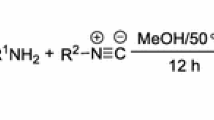Abstract
Lead lactone-based ligands with modest affinity for muscarinic receptors were modified based on structure–activity relationship data in the literature to provide a new series of 5-substituted 4,5-dihydro-2(3H)-furanones. The modifications included the addition of various nitrogen-containing heterocycles attached to substituted and unsubstituted aromatic rings. The target compounds were synthesized in modest yields and evaluated in preliminary muscarinic binding assays. A lactone-based ligand containing a diphenylmethylpiperazine moiety was identified as a nonselective muscarinic ligand with IC50 of 340 nM. The design of future ligands will be based, in part, on structure–activity data reported herein.






Similar content being viewed by others
References
Abrams P, Andersson KE, Buccafusco JJ, Chapple C, Groat WC, Fryer AD, Kay G, Laties A, Nathanson NM, Pasricha PJ, Wein AJ (2006) Muscarinic receptors: their distribution and function in body systems, and the implications for treating overactive bladder. Br J Pharmacol 148:565–578
Ahungena A, Canney DJ (1996) Synthesis and biological evaluation of aminomethyl/amidomethyl derivatives of an anticonvulsant γ-butyrolactone. Med Chem Res 6(9):618–634
Ahungena A, Gabriel JL, Canney DJ (2003) Synthesis and evaluation of 5-substituted derivatives of 4,5-dihydro-3,3-diethyl-2(3H)-furanone as subtype-selective muscarinic leads. Med Chem Res 12(9):481–511
Beers WH, Reich E (1970) Structure and activity of acetylcholine. Nature 228:917–922
Burstein ES, Spalding TA, Brann MR (1998) Structure/function relationships of a G-protein coupling pocket formed by the third intracellular loop of m5 muscarinic receptor. Biochemistry 37:4052–4058
Felder CC, Bymaster FP, Ward J, Delapp N (2000) Therapeutic opportunities for muscarinic receptors in the central nervous system. J Med Chem 43:4333–4353
Johren K, Holtje HD (2002) A model of human M2 muscarinic acetylcholine receptor. J Comput Aided Mol Des 16:795–801
Kaiser C, Spagnuolo CJ, Adams TC, Audia VH, Dupont AC, Hatoum H, Lowe VC, Prosser JC, Sturm BL, Noronha-Blob L (1992) Synthesis and antimuscarinic properties of some N-substituted 5-(aminomethyl)-3,3-diphenyl-2(3H)-furanones. J Med Chem 35:4415–4424
Koch HJ, Haas S, Jurgens T (2005) On the physiological relevance of muscarinic acetylcholine receptors in Alzheimer’s disease. Curr Med Chem 12:2915–2921
Kozlowski JA, Zhou G, Jayaram RT, Lin S, McCombie SW, Ruperto VB, Duffy RA, McQuade RA, Crosby G, Taylor LA, Billard W, Binch H, Lachowicz JE (2002) Substituted 2-(R)-methyl piperazines as muscarinic M2 selective ligands. Bioorg Med Chem Lett 12:791–794
Lewis LM, Sheffler D, Williams R, Bridges TM, Kennedy JP, Brogan JT, Mulder MJ, Williams L, Nalywajko NT, Niswender CM, Weaver CD, Conn PJ, Lindsley CW (2008) Synthesis and SAR of selective muscarinic acetylcholine receptor subtype 1 (M1 mAChR) antagonist. Bioorg Med Chem Lett 18:885–890
Marriott DP, Dougall IG, Meghani P, Liu YJ, Flower DR (1999) Lead generation using pharmacophore mapping and three-dimensional database searching: application to muscarinic M3 receptor antagonists. J Med Chem 42:3210–3216
Nordvall G, Hacksell U (1993) Binding site modeling of muscarinic m1 receptor: a combination of homology-based and indirect approaches. J Med Chem 36:967–976
Ogino Y, Ohtake N, Kobayashi K, Kimura T, Fujikawa T, Hasegawa T, Noguchi K, Mase T (2003) Muscarinic M3 receptor antagonists with (2R)-2[1R-3,3-difluorocyclopentyl]-2-hydroxyphenylacetamide structures. Part 2. Bioorg Med Chem Lett 13:2167–2172
Orjales A, Bordell M, Rubio V (1995) Synthesis and structure–activity relationship of new piperidinyl and piperazinyl derivatives as antiallergics. J Heterocycl Chem 32:707–718
Ostopovici L, Mracec M, Mracec M, Borota A (2007) Exploring the binding site of human muscarinic M3 receptor: homology modeling and docking study. Int J Quantum Chem 107:1794–1802
Pedretti A, Vistoli G, Marconi C, Testa B (2006) Muscarinic receptors: a comparative analysis of structural features and binding modes through homology modelling and molecular docking. Chem Biodivers 3:481–501
Peng JY, Vaidehi N, Hall SE, Goddard WA (2006) The predicted 3D structures of human M1 muscarinic acetylcholine receptor with agonist or antagonist bound. ChemMedChem 1:878–890
Peretto I, Forlani R, Fossati G, Giardina G, Giardini A, Guala M, Porta EL, Petrillo P, Radaelli S, Radice L, Raveglia LF, Santoro E, Scudellaro R, Scarpitta F, Bigogno C, Misiano P, Dondio GM, Rizzi A, Armani E, Amari G, Civelli M, Villetti G, Patacchini R, Bergamaschi M, Delcanale M, Salcedo C, Fernandez AG, Imbimbo BP (2007) Discovery of diaryl imidazolidin-2-one derivatives, a novel class of muscarinic M3 selective antagonists (part 1). J Med Chem 50:1571–1583
Richards MH (1990) Rat hippocampal muscarinic autoreceptors are similar to the M2 (cardiac) subtype: comparison with hippocampal M1, atrial M2 and ileal M3 receptors. Br J Pharmacol 99:753–761
Shapiro G, Floersheim P, Boelsterli J, Bolliger G, Gammenthaler H, Gmelin G, Supavilai P, Walkinshaw M (1992) Muscarinic activity of thiolactone, lactam, lactol and thiolactol analogues of pilocarpine and a hypothetical model for the binding of agonists to the m1 receptor. J Med Chem 35:15–27
Vistoli G, Pedretti A, Dei S, Scapecchi S, Marconi C, Romanelli MN (2008) Docking analyses on human muscarinic receptors: unveiling the subtypes pecularities in agonists binding. Bioorg Med Chem 16:3049–3058
Wess J, Eglen RM, Gautam D (2007) Muscarinic acetylcholine receptors: mutant mice provide new insights for drug development. Nat Rev Drug Discov 6:721–733
Zhao C (2001) Design, synthesis and evaluation of two-substituted quinuclidines: ligands for nicotinic acetylcholine receptors. Dissertation
Acknowledgments
The authors are grateful to Temple University (D. J. C.; Grant-in-Aid of Research) and the Dean’s office, Temple University School of Pharmacy, for generous financial support and to Dr. Magid Abou-Gharbia and Rogelio Martinez (Moulder Center for Drug Discovery Research) for access to instrumentation and helpful discussions regarding this work. R. R. B is thankful to Dr. Schafmeister/Kavita Akula for providing the LC–MS data for test compounds.
Author information
Authors and Affiliations
Corresponding author
Rights and permissions
About this article
Cite this article
Bhandare, R.R., Canney, D.J. Modifications to five-substituted 3,3-diethyl-4,5-dihydro-2(3H)-furanones en route to novel muscarinic receptor ligands. Med Chem Res 20, 558–565 (2011). https://doi.org/10.1007/s00044-010-9349-7
Received:
Accepted:
Published:
Issue Date:
DOI: https://doi.org/10.1007/s00044-010-9349-7




